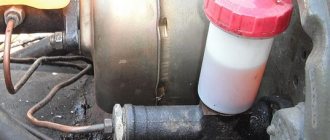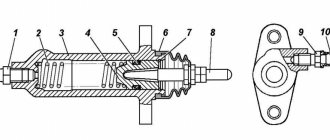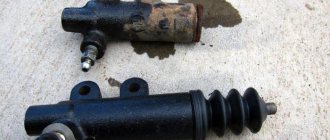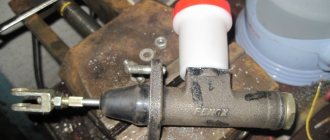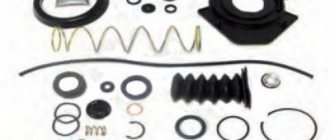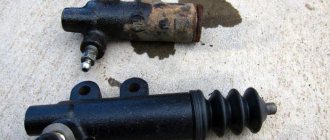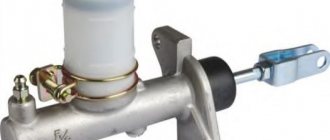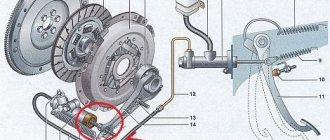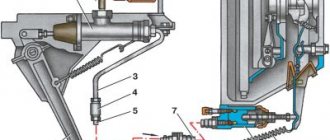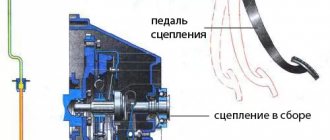General concepts about the clutch system in the Patriot
For beginners, let us explain that the clutch is not a separate element or part, it is a rather large mechanism consisting of different elements: a bearing, a special disk, a basket, necessarily a release pedal and the drive system itself. When driving the UAZ Patriot we are considering, the clutch is always in active condition. When the driver presses the pedal, the clutch disengages, allowing the driver to change gears or enter neutral.
The clutch drive system consists of the following parts:
- Hose;
- Salon pedal;
- Clutch slave cylinder;
- A tube;
- Main cylinder.
The drive system has one job: to transfer force to the fork from the pedal. When the driver of a UAZ Patriot presses the clutch pedal, a piston moves in the master cylinder, pushing the fluid into the working cylinder. When fluid enters the last cylinder, it immediately acts on the fork. And then the fork begins to act on the bearing, and it then acts on the spring. This same spring is the last link; it stops pressing the disc against the flywheel, which is why the clutch is disengaged.
Many car owners, including the UAZ Patriot, are interested in the question of how exactly the clutch cylinder can be adjusted correctly, or rather its free play of the pusher or rod. Before you start adjusting the clutch cylinder, be sure to make sure your vehicle needs it. And in order to find out, an inspection will be required.
Removing air from the drive hydraulic system
Quite rarely, but it happens that the clutch needs bleeding. This can be understood from the fact that it does not turn off completely and the pedal is not pressed so softly. Bleeding is the removal of air from the hydraulic system. This process is carried out when the liquid in the tank is at a normal level.
During work, it is necessary to remove the rubber cap located on the bypass valve and install a hose in this place. Then the other end of the hose is lowered into a 0.5 liter container containing brake fluid in a ratio of 1:3.
Afterwards, the bypass valve must be turned one turn while another person presses the pedal all the way. You need to press the pedal until the air bubbles stop being released. The bypass valve must then be tightly closed.
Some UAZ owners may recommend tightening the bypass valve after each pedal press. This will help to significantly increase the pumping speed and achieve complete neutralization of air. Usually the air disappears from the system after the third or fourth repetition of the operation.
UAZ cars are very reliable. It doesn't take much effort to fix clutch related problems. You can carry out all the work yourself or contact a technical service. Clutch repair or adjustment is not an expensive service. As the owner of one of the UAZ series of cars, you need to carry out timely and constant care of the car, since an unscrupulous attitude can lead to severe pollution and lead to a number of difficult-to-solve problems.
How to check free play on a Patriot
You can check the free play of the rod in the clutch system of a domestic SUV using the instructions below:
- There is a so-called tension spring on the rod, and it should be removed. To do this, you will need to disconnect the fastener that secures the fork to the spring, and then disconnect the spring from the cylinder.
- At this stage of the test, you will need a ruler, with its help you need to measure the free current stroke of the rod. In order for the measurement to be correct, the ruler must be placed correctly. Next, you must press the fork all the way with your hand and, at the same time, put a corresponding mark on the ruler. Then release the fork and make another mark. If the measured distance, which is the free play, exceeds the norm by 1-3mm, then adjustment is definitely required.
When you managed to identify the free play of the rod in the car’s clutch system itself, then only adjustment is required, and not, as many believe, replacement of the master cylinder.
Checking the correctness of the changes made
To confirm the correctness of the results of the adjustments made, it is necessary to check the operation of the clutch assembly with the car engine running.
To do this you need:
- Start the engine and put the car on the handbrake.
- Depress the clutch and engage gear. The lever should move easily to any position, and the speed should not increase.
- Smoothly release the pedal until the crankshaft speed begins to decrease. In this case, the drive must be at a distance from the floor of at least 1/3 of the free play.
- Disengage the clutch and turn off the engine.
After this, the correct adjustment of the sensor is checked while driving. If the speed does not increase when the clutch is turned off, and the machine does not jerk when turned on, then the adjustment has been carried out correctly. Otherwise, you will have to perform all the procedures again.
Instructions for adjusting the free pitch of the rod on a UAZ
Adjusting the rod pitch yourself must begin with completely cleaning the threads of the so-called adjusting nuts. To do this, as many have already guessed, you will need to lubricate the nuts and their threads with a special lubricant; WD-40 is perfect for this purpose. And after thorough lubrication, you can begin the adjustment process on the UAZ Patriot:
- The adjusting nut should be fixed with one key, and the lock nut should be loosened with the second key.
- Next, we will use an 8 key or hand cleats. The end of the pusher must be fixed so that it does not rotate. When the rod is properly secured, you need to unscrew the locknut a few turns.
- At this stage, you can adjust the pitch and bring it back to normal.
- The locknut must be returned to its original position and the stroke of the rod must be fixed.
When the job is finished, be sure to check for free play. If, according to the measurement, it is within the normal range, then you did everything right. As you can see, adjusting the clutch cylinder on the popular UAZ Patriot in our country is not at all difficult and requires a minimum of tools.
Repair
The presence of a diagram of the internal structure of the structure allows you to carry out independent repairs in case of simple malfunctions. Increased fuel and oil consumption, coolant leakage, uncharacteristic noises and knocking in the mechanism are the first indications for repair. Maintenance and replacement of worn-out components helps prolong the functioning of parts and vehicles.
How to adjust the clutch pads
In order to adjust the clutch on a UAZ, you will need to carry out the following repair work:
- Measuring with a ruler the free radius of movement of the drive pedal that turns off the mechanism. The standard value for the spring-lever type should be within the range of 35 to 55 mm, for the diaphragm type - from 5 to 30 mm.
- Measuring the full travel of the pedal after it has been lowered to the limit. The standard value must be found in the operating instructions for your model:
- for cars with a spring-lever type clutch system (Ulyanovsk SUVs of the 3151 family: 31512, 31514 and 31519) it is 18.5 cm;
- for the diaphragm type - on average 16.5 cm. So, for example, for UAZ Hunter it should be set in the range of 13-17 cm, for UAZ 3303 and UAZ 390945 - in the range from 18 to 22 cm.
Adjust the required position by changing the position using the key.
- Controlling the distance when the pedal is lowered between the partition of the motor part and the middle of the rod axis. It is necessary to achieve a value of 9.6 cm. The fork must have a free path of movement of at least 1.7 cm. Changing the length of the work basket pusher is an adjustment tool. To do this, you need to remove and screw back the pusher until the desired value is obtained.
Adjustment of the free play of the clutch pedal is required if the distance between the rotating part located on the release levers and the adjusting screws and elements of the device does not lie within the range of 50.75-52.25 mm. The screws can be removed and put back in until the correct size is established.
Measure the distance from the plate to the heads of each claw screw; it should not differ from each other by more than 0.2 millimeters. Tighten the adjusting screws to set the distance with the required difference. Fixation of each claw screw occurs by pushing the edges of the claws into the grooves of the screw shanks.
When adjustment is required on a Patriot freewheel
It is necessary to adjust the stroke of the pusher directly in the working cylinder, if necessary, so that the clutch correctly performs its task. If the adjustment is not correct, various problems will certainly arise, and in some cases it may even be necessary to replace the slave cylinder.
It happens that incomplete pressing of the pressure plate against the working cylinder occurs. This usually happens when the rod stroke is completely absent or it is significantly below the required norm. Also, at such moments, the driver may notice the clutch slipping, which will certainly and quickly lead to wear and tear on the elements of the entire mechanism.
It happens the other way around, when the free step is greater than permissible, in this case you will notice the clutch is completely disengaged. The driver will certainly feel obvious problems with shifting gears; at first they will shift very poorly, and then stop shifting altogether. Along the way, severe wear of the synchronizer blocking rings will occur.
Adjusting the pedals
For correct operation of the clutch, periodically measure the pedal stroke and, if necessary, set the required values.
Incorrect adjustment can cause problems such as:
- Disc slipping. Incomplete pressing occurs due to the lack of free movement of the pedal.
- The clutch “drives” (incomplete disengagement). It is difficult to change gears. Because of this, rapid wear of the rings and failure of synchronizers occurs.
Problems with the clutch operation of a Patriot SUV can lead to serious consequences.
Measuring full pedal travel
The pedal height is the distance from the pad to the cabin floor. For UAZ produced before 2007, the value should be 13-15 cm, and for UAZ Patriot 2007 and later - 120-140 mm. If the measurement result does not correspond to the set range, the pedal position must be adjusted.
Changing the length of the pusher
To adjust, you need to do the following:
- Loosen the clutch switch sensor (adjusting bolt) and turn it so that it does not touch the pedal.
- Loosen the pusher locknut and rotate to set the required value, then fix the rod.
- Install the sensor so that it touches the pedal, and then tighten it 3/4 of a turn.
After adjustment, re-measure the set length of the master cylinder pusher.
Replacing the clutch slave cylinder of a UAZ Patriot
Yes, the UAZ is mortal, to paraphrase Michal Afanasich, but that would not be so bad. The bad thing is that he is sometimes suddenly mortal.
After 160,000 km and 4 years of operation, I suddenly change the fourth clutch slave cylinder. During the second and third replacement, having read the forums, I chased cast iron cylinders and condemned the Ulyanovsk Automobile Plant for starting to install plastic ones in 2014. Until, thanks to Alexey Drachev and his “AddMount - SUV tuning”, I found out that the reason for its failure was the anthers torn by the rod.
The sharp edges tear the flimsy rubber, exposing the insides of the cylinder body to water from the first ford. Why even buy a UAZ if you don’t drive on fords?! As a result, instant corrosion, premature wear of the cuff, a puddle of brake fluid under the car and the clutch pedal in the floor.
The new type of plastic cylinder, although it is tightened with a screw, has a fundamentally different boot design, working on the principle of an oil seal. However, this does not add much resource to him. My original plastic RCS lasted 50,000 km, as did all the subsequent ones, except the last one, which was not enough for 5,000 km. At the same time, the basket, clutch disc and release plate are still in place from the factory and show no signs of wear.
It, of course, costs less than a thousand and can be changed in half an hour along with pumping. For particularly stubborn UAZ drivers, there is even a repair kit for 150 rubles with an exciting quest to combat the consequences of internal corrosion. But damn! Reliability, and with it the reputation of a car, is made up of little things. Why the hell are you putting up this craft made of shit and sticks in Ulyanovsk, offering your customers a choice of Phoenixes and ADSs of varying degrees of crapness. Is it really difficult to use resource components? The boot is made of normal rubber and the rod should be processed with at least a file. Or at least they did it on quick shots or something...
In this regard, of course, the Patriot with automatic transmission, which I will soon have for a long-term test drive, is of particular relevance, so you can consider this post not as hate, but as an announcement.
Source
The clutch is stuck. Completion. 2016 February. — UAZ Patriot, 2.7 l., 2012 on DRIVE2
Everything was assembled in its place. When installing the clutch and measuring the dimensions of the release valve in height to the supporting planes, it turned out to be lower (I forgot to write down the exact dimensions; in my opinion, the basket from the flywheel to the petals is also lower. I was distracted by something else and didn’t write all this down.
The size of the RCS rod with the factory hitch kit was as follows; the last photo of the rod was completely unscrewed.
During assembly, I decided to do this, in order to at least slightly compensate for the lack of length and unevenness in the plane, I placed a thin 2.5 mm washer under the ball joint of the fork.
To begin with, I unscrewed the rod by 5 mm from the original size. It turned out like this on the rod.
During the first test, the clutch began to grab just above the moment the pedal was released from the floor. The pedal was soft. I went out, drove around, it was unusual and somehow uncomfortable for me, you can’t play with the clutch, it’s already jumping. I arrived, took off the control center, and unscrewed it another 5 mm. I installed the rod with these dimensions. The clutch begins to grab noticeably above the floor. I'll leave it like that.
When installing the RCS, I got tired of pressing it to tighten the bolts, I decided to mechanize this process with a third hand :). That seems to be all. What was done correctly, what was wrong, what was lost_time will show :).
Page 2
Everything was assembled in its place. When installing the clutch and measuring the dimensions of the release valve in height to the supporting planes, it turned out to be lower (I forgot to write down the exact dimensions; in my opinion, the basket from the flywheel to the petals is also lower. I was distracted by something else and didn’t write all this down.
The size of the RCS rod with the factory hitch kit was as follows; the last photo of the rod was completely unscrewed.
During assembly, I decided to do this, in order to at least slightly compensate for the lack of length and unevenness in the plane, I placed a thin 2.5 mm washer under the ball joint of the fork.
To begin with, I unscrewed the rod by 5 mm from the original size. It turned out like this on the rod.
During the first test, the clutch began to grab just above the moment the pedal was released from the floor. The pedal was soft. I went out, drove around, it was unusual and somehow uncomfortable for me, you can’t play with the clutch, it’s already jumping. I arrived, took off the control center, and unscrewed it another 5 mm. I installed the rod with these dimensions. The clutch begins to grab noticeably above the floor. I'll leave it like that.
When installing the RCS, I got tired of pressing it to tighten the bolts, I decided to mechanize this process with a third hand :). That seems to be all. What was done correctly, what was wrong, what was lost_time will show :).
How to remove the clutch slave cylinder UAZ Patriot
Remove the slave cylinder for replacement if the clutch is not fully disengaged due to fluid leakage
You will need: a 17mm wrench, a 12mm socket, a ratchet.
Attention! The length of pusher 8 is 112 mm. Do not adjust the length of the pusher during operation.
Unscrew the bolt fitting securing the hose coupling to the clutch release slave cylinder
Disconnect the hose from the cylinder.
Be careful not to lose the sealing washers installed on both sides of the hose coupling.
Remove the two bolts securing the clutch release slave cylinder to the clutch housing
Install the clutch release slave cylinder in the reverse order of removal.
Remove air from the clutch release hydraulic drive (see Bleeding the UAZ Patriot clutch).
Working cylinder bulkhead
Disassemble the working cylinder in the following order:
— disconnect the rubber protective cap 6 from the working cylinder (Fig. 1) and remove the pusher 8 along with the cap;
— remove the cap from the pusher;
— remove retaining ring 7 from the working cylinder body;
— remove piston 4 with sealing collar and spring 2 from the cylinder body; to avoid
damage to the piston and cuff supply compressed air
— remove sealing collar 5 from the piston;
— unscrew the bypass valve 9;
— remove the protective cap from the valve.
Wash the working cylinder parts thoroughly in brake fluid or alcohol, blow with compressed air and inspect.
All rubber cylinder seals must be soft and elastic.
Replace any hardened, swollen or rips or cracks on the working surfaces.
The master cylinder mirror should not have marks, holes, or significant wear.
When assembling the working cylinder, you need to make sure that the spring confidently moves the piston in the cylinder until it stops against the retaining ring.
Source
Possible malfunctions and their diagnosis
Signs indicating malfunctions in the clutch drive can be diagnosed based on the following: - The level in the clutch reservoir has dropped significantly, this indicates that brake fluid is leaking somewhere in the system; if the connecting tubes are intact, then this may be caused by worn cuffs or piston failure in the master cylinder. — A visual inspection showed the presence of places where fluid was leaking: tubes, cuffs, etc. — When pressed, periodic failures of the pedal occur, this indicates that there is air in the clutch drive, this happens when hoses are cracked or when the level in the reservoir drops below the minimum. — Gears do not change. — The clutch pedal has “failed”
If these signs are present, you should check all components of the clutch drive, carry out diagnostics and subsequent repair or replacement of failed parts.
Replacing the clutch slave cylinder of a UAZ Patriot
The clutch slave cylinder is part of the hydraulic clutch engagement control system. When this circuit depressurizes and brake fluid leaks, the system begins to work ineffectively. This definition can also be applied to the clutch slave cylinder, which can pass fluid both outward and through itself. In the first case, brake fluid leaks along the body will be noticeable. In the second, there will be no noticeable leaks, which complicates the diagnosis of the malfunction. So, if you have determined that the UAZ Patriot clutch slave cylinder needs to be replaced, then in this article we will tell you about the procedure for replacing it.
The procedure for replacing the clutch slave cylinder of a UAZ Patriot
To replace it, it is necessary to purchase a new clutch slave cylinder; it is impractical to repair the old one. For example, you can purchase a Fenox P2520C3 cylinder or another similar one. To replace, you will also need a 17mm wrench and a 12mm spanner or socket. The procedure for replacing the cylinder is quite simple, except that difficulties will arise with the location of the working cylinder. To replace it, you may have to remove the protection and remove the clutch slave cylinder from below.
First of all, unscrew the bolt that holds the rubber hose and ensures a tight connection between it and the cylinder body.
Disconnect the hose... Afterwards, it is better to wrap the hose in polyethylene to prevent brake fluid from leaking out.
Be careful not to lose the copper gaskets installed on both sides of the retaining bolt. When tightening the bolt again, it is better to replace them with new ones.
Use a socket wrench or a 12mm wrench to unscrew the two retaining bolts of the UAZ Patriot clutch slave cylinder.
Remove the clutch slave cylinder from the car.
Installation of the part is carried out in the reverse order.
After installing the cylinder, it will be necessary to bleed the hydraulic clutch system.
Source
The need for the unit and types
Clutch disc for Patriot
The clutch must always be engaged. It is used only for stopping completely, starting to move, and changing gears. The resource of the release lever will be reduced if you keep your foot on the clutch pedal all the time. Sometimes it is partially squeezed out, then the brake discs become unusable.
The box is an engine, the wheels are automatically separated from each other. The clutch facilitates the disconnection of the motor from the box, and then a uniform connection.
- mechanical;
- hydraulic;
- galvanic;
- drive in combination.
- dry;
- moist (in an oily sphere).
Number of driven disks:
Placement of spring releases:
- cylindrical springs are located at the edges of the pressure disk;
- central diaphragm spring.
- flywheel;
- driven disk;
- disk compression springs to the flywheel;
- switches;
- hydraulic pressure coupling;
- accelerator pin;
- the pedal itself;
- pressure disk;
- release lever;
- release (thrust) ball bearing;
- original box shaft.
Causes of wear
Clutch replacement occurs in the following cases:
- Wear due to slipping when starting off,
- discrepancy between engine speed and driving speed as a result of clutch wear,
- The car jerks when starting off.
In the first case, the car does not have enough torque to start moving. When the speed is turned on, sufficient speed is maintained, but the car does not start to move. In such situations, the clutch linings wear out.
The latter case is associated with weakening of the damper springs on the clutch disc. Weak springs do not absorb shocks. This malfunction is aggravated by frequent off-road driving and when replacing standard wheels with larger wheels.
Using the pedal lever
First, slowly release the clutch pedal. The driven disk comes into immediate contact with the flywheel. The friction power contributes to the rotation of the flywheel, and the machine begins to create the first movements along the roadway.
Next, the circulation of the disk and flywheel must be equal. The pedal holds a certain level for some time, slowly returning to its original position. The speed increases little by little.
Everything works together: the flywheel, the release plate, the driven disk - they gain a similar amplitude of rotation, then transmit the torque to the machine’s gearbox and wheels. The mechanism is engaged, the car is moving, you can remove your foot from the clutch.
Replacing the bearing and clutch release fork
To disengage the clutch, you need to press the clutch pedal with your foot. At this moment, the pressure disk moves away from the flywheel, the driven disk is released, and the torque period to the gearbox from the motor is interrupted. The pedal pressure should be soft and fast, but there should be no harshness.
Petal clutch is called diaphragm clutch. This is a type of clutch where a diaphragm spring transmits the force to the pressure plate. The outer diameter of the pressure plate is standardized, and the inner diameter, in contact with the clutch release bearings, consists of metal petals. The clutch petal basket consists of a pressure plate, a housing, and a diaphragm spring. It can be press or pull, the latter is not often used.
Principle of operation
UAZ Patriot cars have the following type of clutch: single-disk with a centrally located diaphragm spring. By the type of friction it is dry, by the mode of activation it is constantly closed. Diaphragm clutch is also called petal clutch. This type is also used in other UAZ models: 3741 “loaf”, SUVs 469, 3151. Petal is also used for cars of other brands.
It consists of the following parts:
- pressure disk (basket),
- clutch disc (driven),
- release bearing,
- release bearing drive fork,
- drive system,
- off pedal.
The pressure plate is housed in a stamped steel housing, bolted to the engine flywheel. The driven disk is clamped by a spring, it is located between the flywheel and the pressure plate. During operation, the closed type bearing does not require lubrication.
clutch release drive on UAZ Patriot vehicles Its composition:
The purpose of the drive is to transmit force from the pedal to the fork. When the pedal is applied, a piston located in the master cylinder moves and forces fluid through a pipeline into the slave cylinder. A piston placed in the slave cylinder acts on the clutch release fork. Then the fork moves the bearing along the guide. The bearing, in turn, acts on the diaphragm spring, which stops pressing the pressure plate against the flywheel. The clutch switches off.
Paddle clutch has the following advantages:
- less weight of parts,
- smaller part size,
- long service life of parts before the next maintenance,
- improved functionality,
- easier maintenance.
Features of operation and operation of the UAZ clutch drive.
When the clutch pedal is abruptly released, a single knock is possible due to the choice of lateral clearances in the toothed connections of the gears, splined connections and in the gearbox synchronizers.
If, while driving, when you sharply press the gas pedal, the engine speed rises sharply, and then drops slightly and the car begins to accelerate, then the clutch requires repair or replacement. In order to reduce clutch wear and extend its service life, it is advisable to follow these simple recommendations:
— it is not recommended to constantly keep your foot on the clutch pedal, since it is depressed at least a little, the driven disk slips and wears out faster, in addition, although the release bearing is designed to operate in constant rotation mode, even with the pedal pressed slightly clutch, it is under load and therefore its service life is reduced
— for the same reason, it is not recommended to keep the clutch in the disengaged state for a long time, for example, before a traffic light; if you do not need to move away immediately, it is better to put the gearbox in neutral and release the clutch pedal.
Checking free play
Checking the free play of the working cylinder rod of a UAZ Patriot SUV is carried out as follows:
- This element has a tension spring installed on it, which must be removed. To do this, first disconnect the spring mount from the fork, and then from the cylinder.
- Next, you will need to use a ruler to measure the free play of the rod. To measure, the ruler must be positioned so that the measurement can be taken. After this, you need to press the fork all the way with your hand and put a mark on the ruler. Then release the fork and also make a mark. If the resulting distance (free play) exceeds the norm (1-3 mm), then adjustment is required.
So, having found out that the free play of the working element rod on the UAZ Patriot SUV exceeds the norm, you need to resort to the process of adjusting it.
Paddle clutch: priority
- The working “legs” of the exhaust system require systematic attention and adjustment, unlike the diaphragm hitch.
- With a lever clutch, the driven disc wears out faster. The petal type works more productively, without slipping.
- When the accelerator pressure of the diaphragm clutch is calm, then the service life of the release bearing will be long.
The clutch of the UAZ Patriot SUV is dry, single-disc, with a diaphragm-type center pressure spring, hydraulically driven.
One of the components of the clutch paddle drive system of a UAZ Patriot is a slave cylinder that performs a specific chain function: it takes the voltage coming from the main clutch, moves the release fork, and the pressure ball bearing.
Clutch slave cylinder: replacing it yourself
There is no need for mandatory consultation with car repair specialists; you can try to figure it out yourself.
Dismantling the old unit
To disassemble the clutch release master cylinder, you will need some tools:
- repair kit for replacing old parts; any auto store will offer a large number of spare parts;
- a vice to support the cylinder at the time of work;
- tool for metalwork.
Disassembling the unit begins with removing the cap with the pusher, then the retaining ring, and the piston itself. After this, the spring and seal nut are removed, which clearly must be replaced, even if its integrity is not compromised. The nozzles of the fitting and cylinder are cleaned of dust and contaminants.
Parts of the master cylinder (MCC) are inspected to identify mechanical damage. Regardless of the integrity of the cap, it must be replaced. All parts of the assembly are washed with brake fluid. In no case is it recommended to use petroleum products, oil, or diesel fuel due to the swelling of rubber parts.
During reassembly, all parts must take their place in the unit. All parts are installed; there should be no extra spare parts left. Everything is done correctly, which means the unit is ready for use.
At the end of the work, it is necessary to bleed the hydraulic drive system. If the entire system malfunctions, be sure to replace the clutch master cylinder with a new one.
In order to prevent waste from flowing out of the clutch release pipe, you need to close the end of the pipeline with a cap.
